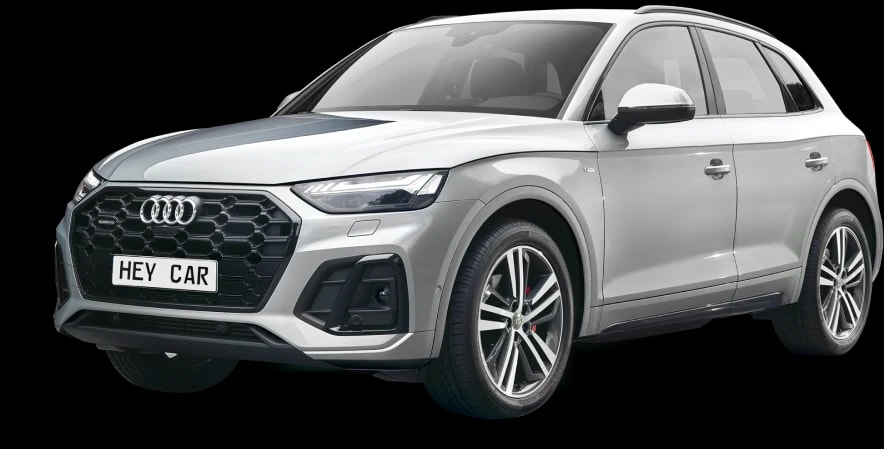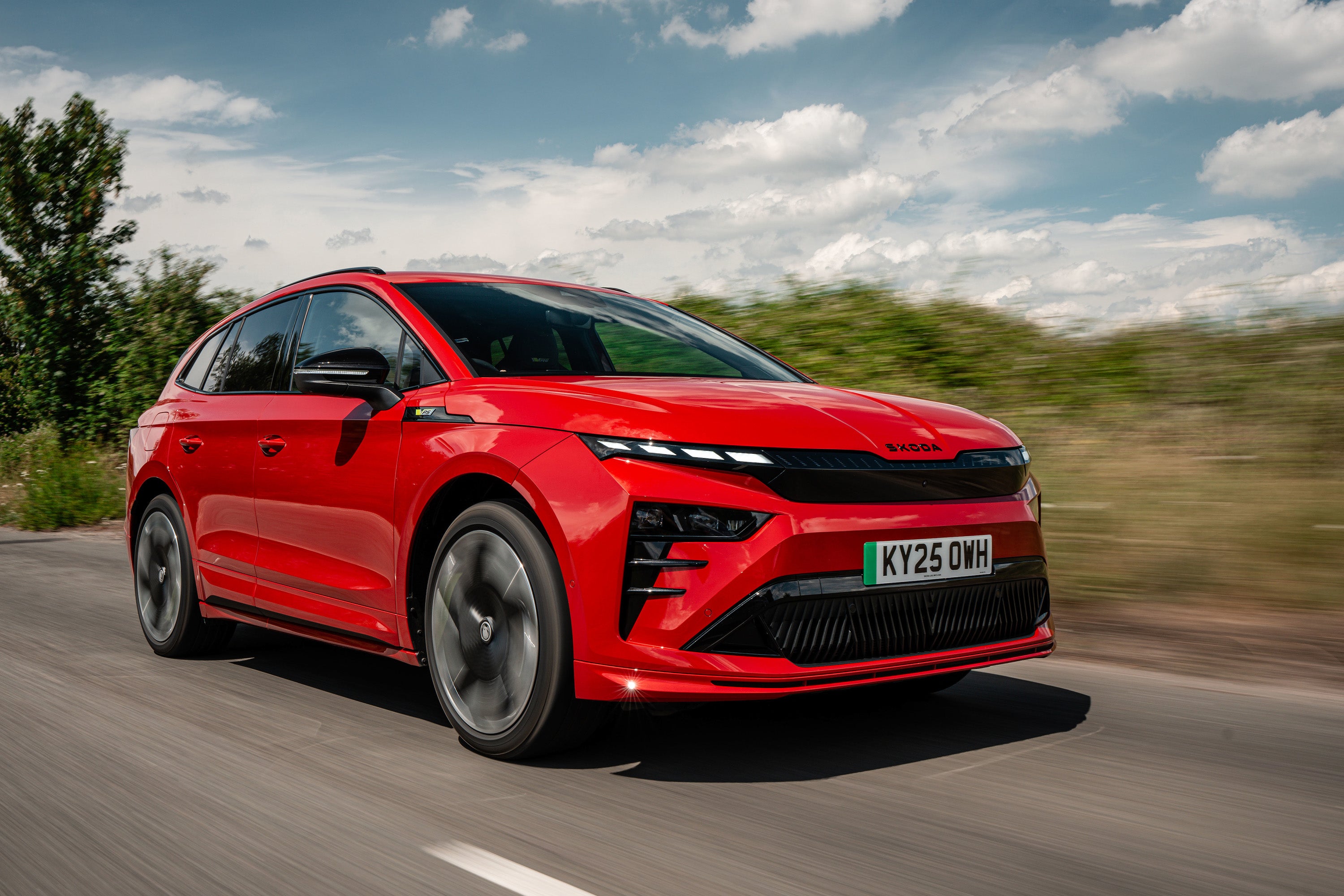Skoda Enyaq vRS Review 2025: Price, specs & boot space
Written by Matt Robinson
- 2023
- SUV
- EV
Quick overview
Pros
- Still very refined and practical
- Gets lots of standard equipment
- More recent versions are quicker
Cons
- Nowhere near as fast or fun as you'd hope for a sporty EV
- Premium pricing for a Skoda
- Really doesn't offer much over high-spec regular Enyaq iV
Verdict: Is the Skoda Enyaq vRS a good car?
"Thanks to an uplift in power and torque, the Enyaq vRS feels like a more convincing performance car, although it's still lacking outright thrills. Set your expectations accordingly, and you'll find a quick and well-rounded SUV, just not one that'll leave you wanting to take the twistier way home.
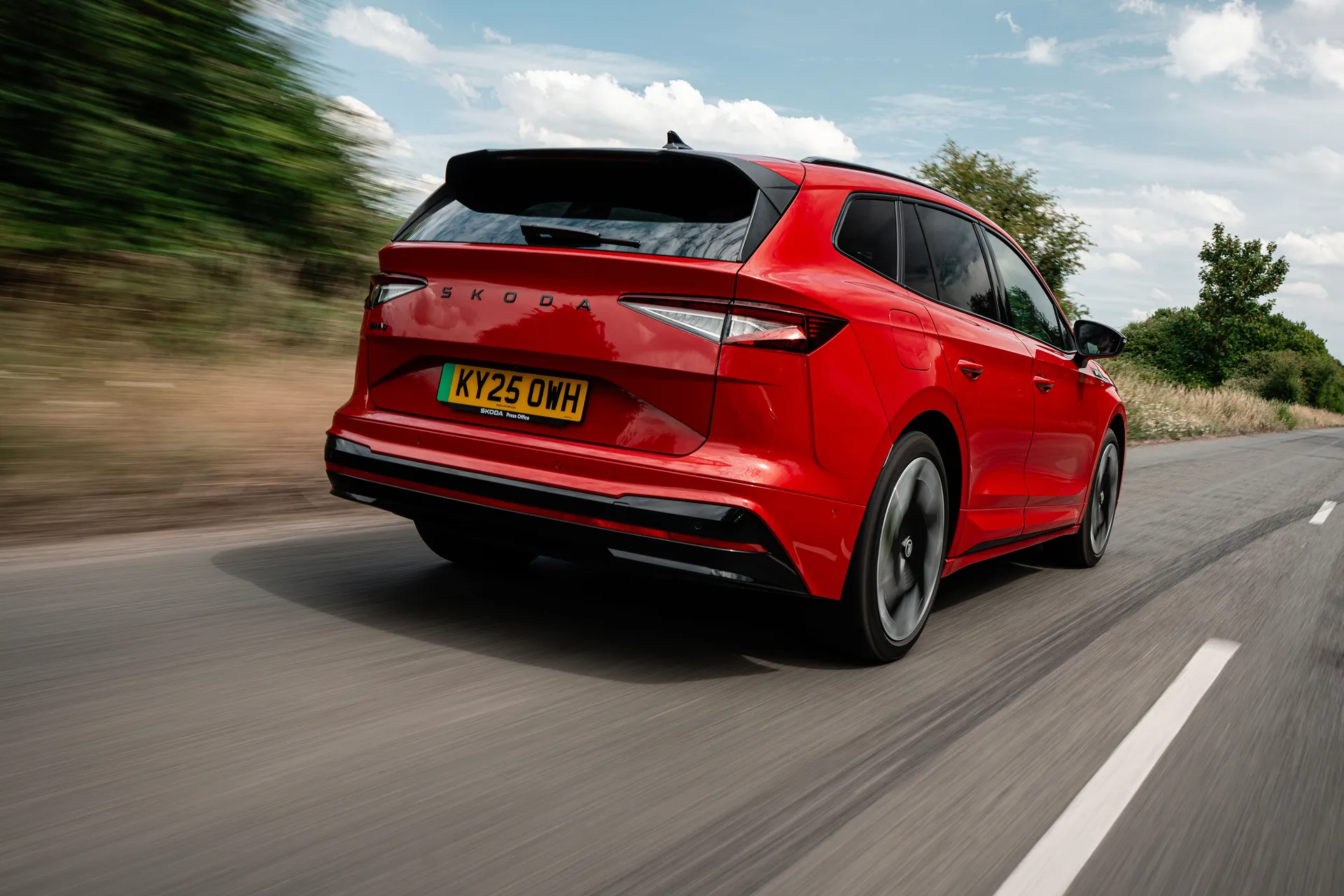
Making an electric car go faster isn't that hard - you just turn up the wick on the electric motors a bit. Making an electric car that looks and feels sporty is a bit more difficult, however, what with the significant extra weight and smooth, silent propulsion compared with a petrol or diesel car.
Skoda has had a couple of decades of experience with performance variants through its popular vRS division. While there's no longer a vRS version of the Fabia supermini you can still get the brilliantly do-all Skoda Octavia vRS and the slightly oddball Kodiaq vRS. Both offer strong performance from meaty turbo petrol engines (previously diesel on the Kodiaq), racier looks and tidy handling.
But Skoda, like other VW Group brands, is pushing for an electric future. The Skoda Enyaq iV is one of our favourite electric SUVs and is selling strongly, so it's only natural that the brand would want to add an appealing (and more profitable) range-topping variant. Enter the Skoda Enyaq iV vRS, first available as a hot version of the Enyaq Coupe and then in regular form later in 2023.
Normally, a performance variant (like BMW M and Audi RS) is festooned with badges shouting about it, but if you approach the Enyaq iV vRS from the rear, you won't notice anything different over a Sportline trim level. It's mainly the badging on the front wings that marks it out, plus some light styling differences. Earlier versions had a controversial 'Crystal Face' - an LED backlit grille, although this was dropped when the car was facelifted in 2025.
While that might not be to all tastes, we like the interior additions, including sports seats and carbon (or Alcantara in some markets) dash trim. It's not drastically different from the regular Skoda Enyaq iV, though, which means it's comfortable, solidly built and impressively spacious, with a big boot even on the Coupe.
Let's get to the meat of the matter, though: what's different under the skin? Well, the Skoda Enyaq iV vRS puts out up to 340PS (we'll explain 'up to' in the driving section later), which is 54PS up on the next most powerful Enyaq, although if you're buying an earlier one, it'll be a more modest 299PS. You also get all-wheel drive, lowered suspension and upgraded steering.
We're not talking drastic changes, then, and that shows when you drive it. The Enyaq iV vRS is a bit faster than the Enyaq 85x, yes, and the uplift in power from 2024 did make a noticeable improvement to the performance. But the Enyaq still isn't all that quick for what's billed as a performance EV.
That relative lack of excitement is echoed in the handling, too, which is largely predictable and composed but not particularly fun at any point despite those suspension tweaks. It's hard to escape the feeling that the Skoda Enyaq iV vRS is merely a high-end trim level rather than a dedicated sporty model in its own right - something which the Octavia vRS definitely feels like.
At least opting for the vRS doesn't kill the car's electric range, with both regular and Coupe models managing an official range of over 300 miles. You get pretty quick charging, too, although it's not class-leading in that respect.
With both versions priced over £50,000 you might well baulk, but that price is broadly competitive with rivals. Even so, it's hard to escape the feeling that there's a much better all-rounder lower down the Skoda Enyaq's range. It's a brilliant electric car, just not in this form.
Is the Skoda Enyaq vRS right for you?
If you're eyeing up an engaging, fun electric performance car, we'd have to say no. Don't be fooled by the badge – the Enyaq vRS is no more exciting to drive than similarly priced electric SUVs that do without sporty branding.
If, however, you're already looking at the more expensive end of the Enyaq range (which you'll definitely be doing with the Enyaq Coupe, because it's only available with higher trim grades), the vRS is an easier sell. It is, really, best looked at as a trim level, and if you want all the mod cons with the bonus of some extra performance, it might make sense.
Viewing the Enyaq range as a whole, though, we reckon the cheaper, smaller battery versions of the car make the most sense, unless you simply must have the range of the 85 battery.
What's the best Skoda Enyaq vRS model/engine to choose?
The only choice you'll have to make when weighing up the Skoda Enyaq iV vRS is whether to buy the Coupe or the regular model. The Coupe was made available to order first, with the regular car arriving in mid-January 2023.
For us, that's an easy choice to make. Not only is the Coupe more expensive to buy, but it's also a little bit less practical and harder to see out of when looking behind you. Couple that with the fact that (to this tester's eyes) it doesn't actually look as cohesive as the regular car, and we really don't see the point.
As for colour, the launch hue (as you can tell from the images) is the rather bold Hyper Green. Great if you want to stand out, terrible if you like to pass under the radar. Thankfully a range of less out-there colours can be had.
What other cars are similar to the Skoda Enyaq vRS?
By turning the Skoda Enyaq iV into a vRS model the list of key rivals changes a bit, moving away from 'normal' electric SUVs into models with a bit of a sporting bent.
Probably its main competitor is the Kia EV6, which is sportier and more dynamic-looking than the Hyundai Ioniq 5. Another key challenger is the Polestar 2, which isn't as roomy but is fast and stylish, while the Ford Mustang Mach-e definitely gets a look in.
VW's own ID.4 and ID.5 GTX are also largely identical underneath to the Enyaq iV vRS. Meanwhile buyers looking for a more premium sporting EV should head towards the Jaguar I-Pace or BMW iX3.
Also worth considering are the even faster but more expensive Volvo EC40 and Tesla Model Y.
Comfort and design: Skoda Enyaq iV vRS interior
"The Skoda Enyaq iV vRS is broadly the same as the standard Enyaq inside, but you do get some nicer upholstery and finishes."
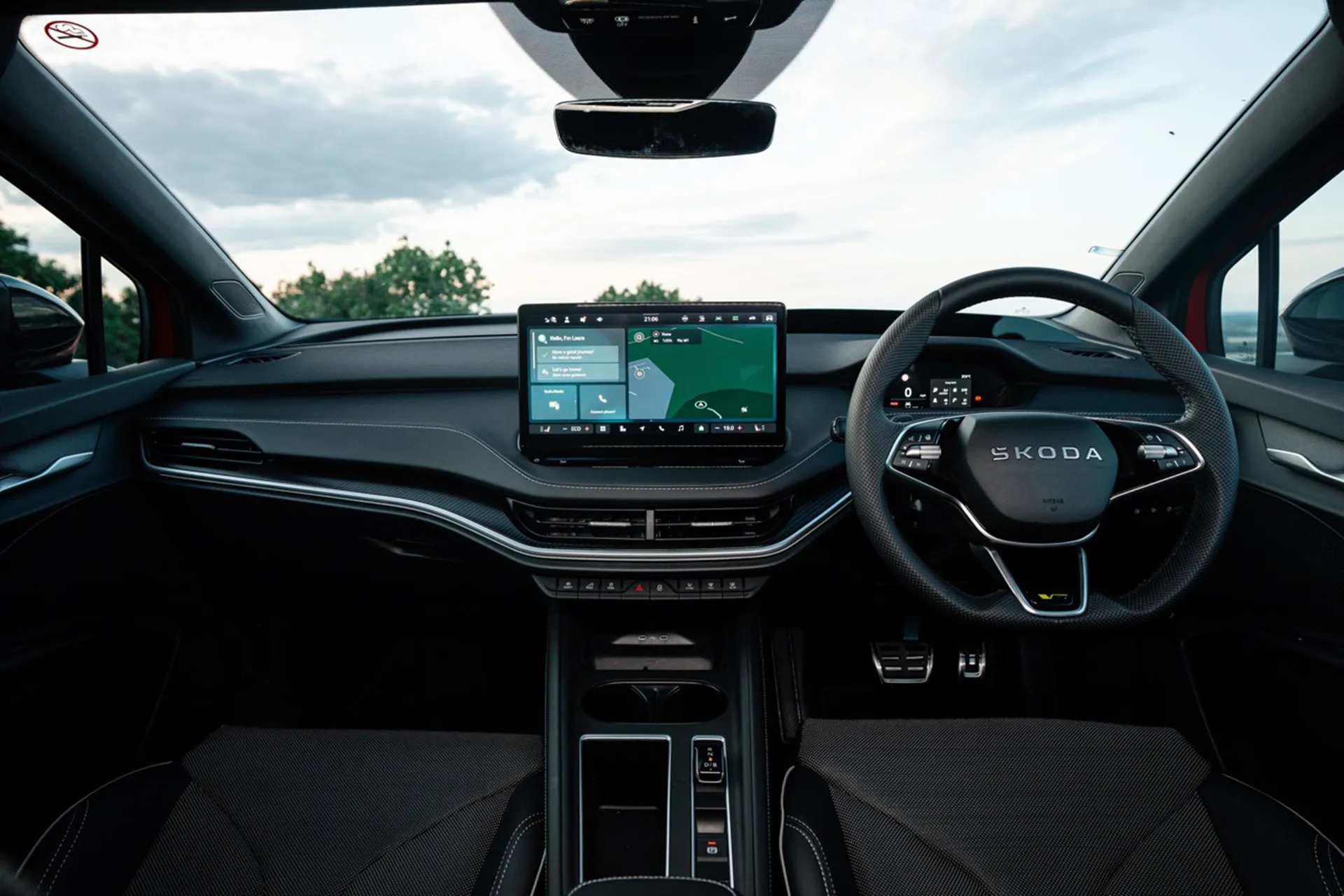
The cabin of the Skoda Enyaq iV vRS (and the Coupe) comes with what's called the 'vRS Suite Design Selection'. It sounds like something from Ikea, but it basically means carbon effect inserts on the dash, aluminium pedals and perforated leather sports seats. There's also a slightly sportier three-spoke steering wheel.
Depending on your market, other European countries get the option of an Alcantara dash and green stitching, and it's a shame this isn't offered in countries such as the UK because it feels and looks a bit more special. As with the regular car, the design is relatively attractive and the layout is easy to get on with.
Sports seats with integrated headrests are standard fitment, but you already get those (albeit in a less racy upholstery) in the Enyaq Sportline. They're comfortable and widely adjustable, however. It's easy to find an ideal driving position with plenty of wheel adjustment, too, while visibility up front is good thanks to a low windscreen bottom.
It's worth bearing in mind that visibility out the back of the vRS Coupe is restricted by the rake and size of the rear screen. If having a good view out the back is important, we'd go for the regular model.
Quality and finish
The regular Skoda Enyaq is already a pretty solid base quality-wise, somewhat showing up its pricier VW sibling and offering generally excellent fit-and-finish.
Plumping for the vRS model adds the aforementioned posher trims along the dash and doors, plus nicer seats, which helps lift things a bit. Other than this and the occasional vRS badge, it's not drastically different, however.
Infotainment: Touchscreen, USB, nav and stereo in the Skoda Enyaq iV vRS
Every Skoda Enyaq vRS comes equipped with a 13-inch touchscreen infotainment system, just like the standard Enyaq. As well as standard sat-nav there is DAB radio, Apple CarPlay and Android Auto, as you'd expect at this price point.
It's easy to operate with quick responses to jabs of the finger, while its graphics are typical Volkswagen Group smart. It's not perfect, though – we noticed that its position means it does seem to attract reflections on a sunny day, while having the climate control functions within the screen is more fiddly on the move than physical controls.
At least the temperature and fan section is always at the bottom of the screen, and it's much less awkward to use than the VW ID.4 and ID.5's silly haptic sliders below the screen. You also get a handful of physical shortcut buttons on a plinth below the screen.
All Skoda Enyaq models get a digital display rather than conventional dials. This is functional rather than fancy, with a rather small display relative to some rivals.
A head-up display system is available as part of the Advanced Package. This projects key data like your current speed and navigation directions into your field of view – useful, but not at £2,335 unless you want the heated rear seats and heated windscreen that also come in this package.
Space and practicality: Skoda Enyaq iV vRS boot space
There's no real difference between the regular Skoda Enyaq and the Enyaq vRS here, although there's a slight practicality disadvantage if you go for the Coupe version.
Space and practicality is always a Skoda forte, and the Enyaq is a pleasingly spacious car all-round. Head and leg space up front is generous, even if you're over six foot, and the interior is nice and wide to keep you from bumping arms with the passenger. Storage throughout is good, too.
In the rear, too, things are largely excellent, and again, two burly adults can get plenty comfortable here. There's enough width for three to tackle short journeys, too, although the middle seat's legroom is slightly compromised by the front centre console which juts out. The only disappointment is that, despite being not far off the size of the Skoda Kodiaq, there's no seven-seat version available.
It's in the back where the differences for the Skoda Enyaq Coupe iV vRS come to the fore, because there is a fraction less headroom in the rear of the Coupe due to that sloping roofline. It's really not drastic, however, so only the extremely tall will notice.
The Skoda Enyaq iV vRS's 585-litre boot capacity is very large even for an SUV, meaning this is a class-leading family SUV for outright space. Bear in mind that the Enyaq Coupe loses 15 litres of space due to the reshaped rear, but it's minor. Fold the rear seats down and there's a vast space for a bike or similar.
In terms of exterior dimensions, the Skoda Enyaq iV vRS is pretty identical to the standard car, at 4649mm long, 1879mm wide excluding mirrors and 1605mm tall (slightly lower due to the dropped suspension).
Handling and ride quality: What is the Skoda Enyaq vRS like to drive?
"Skoda has given the Enyaq iV vRS lowered suspension and revised steering, which should make it feel noticeably keener in the bends. But does it?"
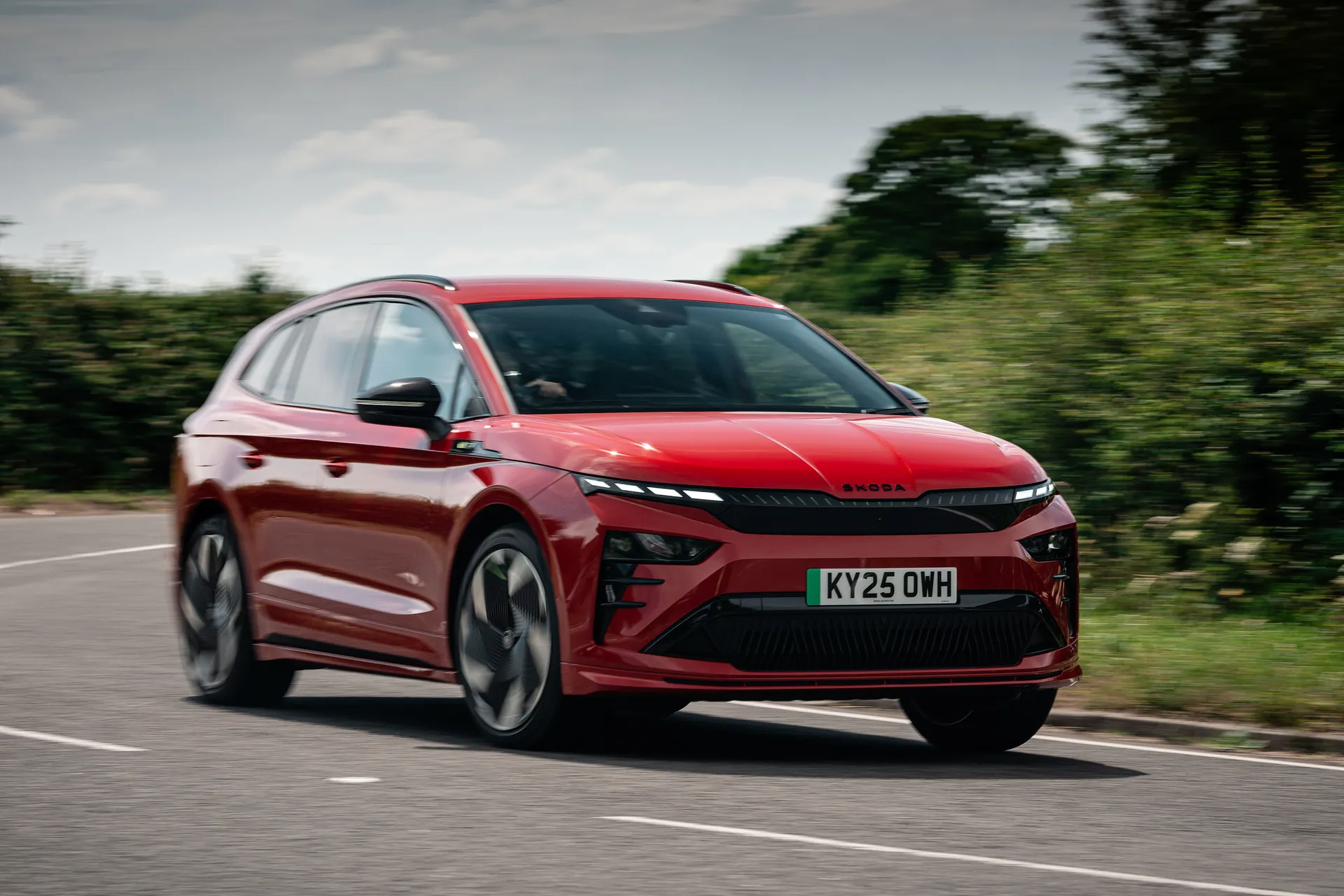
Compared to the regular Skoda Enyaq iV the vRS model sits 15mm lower at the front and 10mm lower at the back than the standard Enyaq, thanks to revised suspension. This should reduce how much the body rolls around in corners and enhance agility.
There's also progressive steering fitted as standard, which aims to make it more direct and stable at high speeds and easier to twirl around town at low speeds. Adaptive dampers (that make the ride softer or firmer depending on drive mode) are optional but weren't fitted to our early production test car for reasons that weren't explained.
Sounds like a recipe for more fun, yes? In practice, we're not so sure. Yes, there is a touch less body lean when you really attack a series of corners, but it's not significantly more agile than a Skoda Enyaq Sportline. You do get a Sport mode for the stability control (another vRS-specific feature) which gives it a bit of a rear-wheel drive feel, but it's not that noticeable.
The steering is pretty direct and nicely weighted (albeit numb), but then progressive steering is also standard on a regular Enyaq Sportline, which also gets slightly sportier suspension than a normal Enyaq. Really, the vRS doesn't feel much different than that car, even driven back-to-back. Is it sporty? Not really, if we're honest, regardless of which of the multiple drive modes you have it in. A Kia EV6 or Polestar 2 feels a fair bit more lively.
The upside is that the ride isn't really any worse than a regular high-spec Enyaq. Sure, the bigger wheels thump about a bit over rough tarmac, but it's generally pretty smooth and plenty comfortable enough on the motorway. The brake pedal feel isn't an issue either - sometimes in electric cars or hybrids, it can be tricky to judge.
What motors and batteries are available in the Skoda Enyaq vRS?
There's only one engine (and no gearbox to speak of) in the Skoda Enyaq iV vRS. With dual motors giving it four-wheel drive, the power output was originally 299PS, with 460Nm of torque.
That sounds like plenty, but when you consider that the Enyaq weighs well over two tonnes, it's not a vast reserve. And even then, Skoda was cheating a bit, with that full power only available for 30 seconds as a 'boost' function. You won't get that full figure with a low battery charge, either.
Things got better in 2024, when Skoda bumped the power up to 340PS and the torque to 545Nm. This dropped the 0-62mph time to a much more respectable 5.5 seconds, and a further tenth was shaved off that thanks to software tweaks at the time of the car's 2025 facelift. The resulting 5.4-second 0-62mph dash is identical to that of the Elroq vRS, which is only 10kg lighter despite being a fair bit smaller.
Have a look at the small print, and you'll still find that you won't always get the full beans in the Enyaq vRS. "The maximum power is available when the high-voltage battery is at its highest possible state of charge (SoC) and operating within its optimal temperature range," it says. Boo.
But still, the car does actually feel quite quick now, and has enough get up and go to pin you to your seat, if not with the violence of something like the most pokey Tesla Model Y, which manages 0-62mph in just 3.5 seconds. Throttle response, too, is nice and sharp, even when you're not in Sport mode.
Skoda Enyaq vRS range: How far can you travel on a charge?
Extra performance always comes at a price, and in electric cars it's usually range. The Enyaq iV vRS is also four-wheel drive which has an impact too. Happily, the drop compared to the regular Enyaq isn't too steep at all.
As standard it gets an 82kWh battery (77kWh of that is usable), translating to an official WLTP range of 344 miles. Realistically that probably translates to 280-320 miles of range, depending on where you're driving it - it'll be less efficient on a motorway.
There's a little bonus if you go for the Enyaq Coupe iV vRS, which officially does 347 miles on a charge because its body shape cuts through the air more cleanly. That's hardly a deal-breaker, but every little helps.
We're not sure why or how, but Skoda quotes a range of only 332 miles for the slightly less powerful Enyaq iV 85x Sportline Plus, which also has four-wheel drive. The rear-wheel drive 85 manages 365 miles.
Refinement and noise levels
The Skoda Enyaq iV vRS is as refined and smooth as you'd expect any electric car to be. There's no rumble of an engine, no whine or jerk of gears and a generally relaxing demeanour.
And that's great in a regular family SUV, but it doesn't really help the case of the vRS in being a performance model aimed more at enthusiasts. The lack of any sound or sensation beyond the outright acceleration (which is hardly neck-snapping) means it isn't exactly engaging for the keen driver. Some may disagree, but we'd actually like some kind of synthesised noise as you accelerate like some rivals have - it at least gives you something to titivate the senses.
Still, the benefit of Skoda not fitting rock-hard suspension to the Enyaq iV vRS means it's pretty much as refined as the standard car. That means a small amount of wind noise on the motorway, while there's some tyre roar as to be expected with large wheels and no engine note to disguise it.
Safety equipment: How safe is the Skoda Enyaq vRS?
Standard safety equipment in the Skoda Enyaq iV vRS (as with any Enyaq) includes front side airbags and curtain airbags, driver and front passenger airbags with passenger airbag deactivation, lane assist and front assist with assisted automatic braking. There are Isofix child seat points on the front passenger seat and outer rear seats. Rear side airbags are available as an optional extra.
Also included on this range-topping model is blind spot detection, Adaptive cruise control with traffic jam assist, traffic sign recognition and Crew Protect Assist, which quickly prepares the car in the event of a serious imminent crash or rollover.
The Enyaq has been awarded a five star safety rating by Euro NCAP as a result, with strong scores across the board.
Skoda Enyaq vRS charging times: How much does it cost to charge?
"More recent versions of the Enyaq iV vRS can charge at up to 175kW, so in the right conditions and with a potent enough charging station, you can top up from 10 to 80% in 28 minutes."
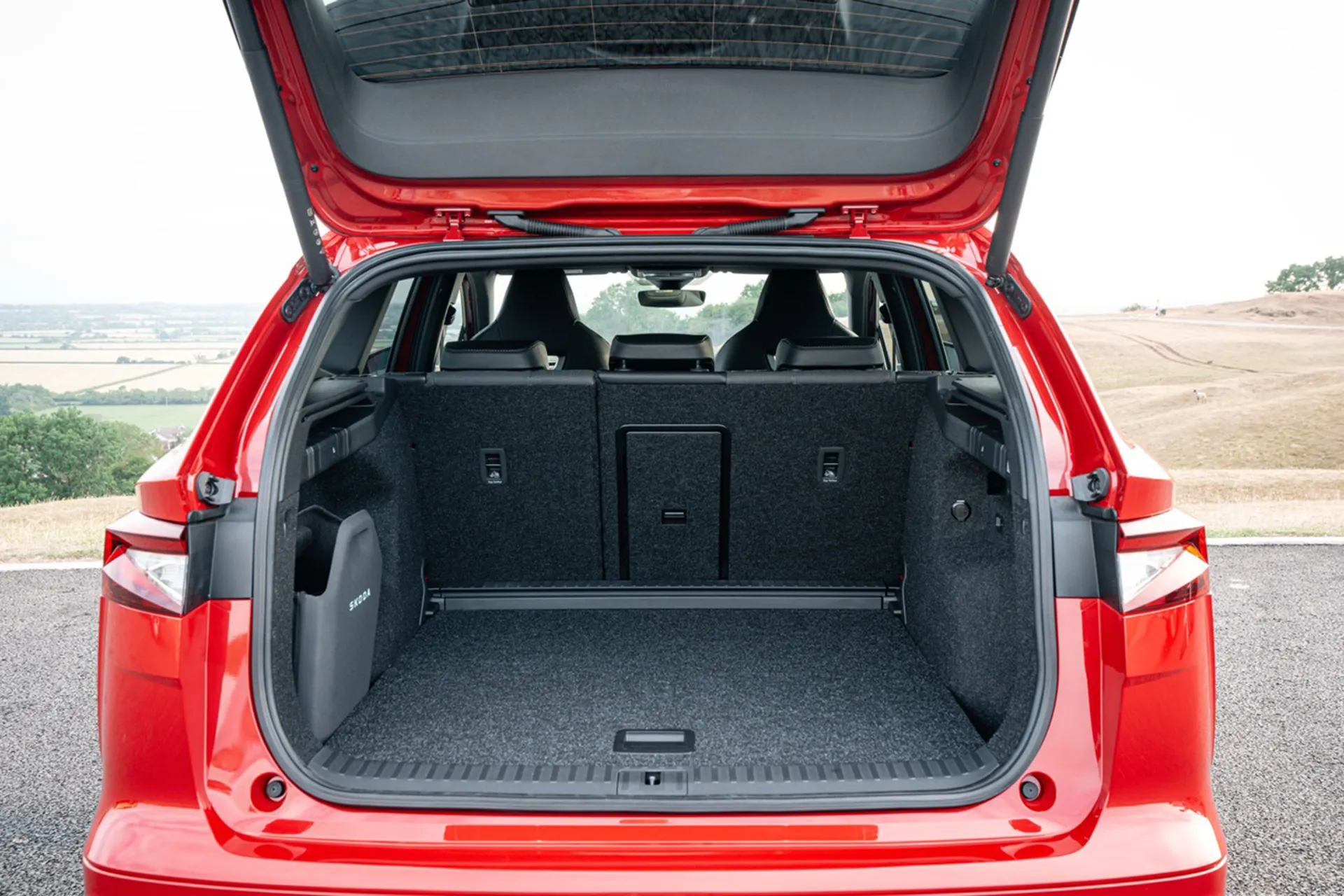
If you're buying an older version, don't worry, you'll only be waiting another eight minutes. Spend a bit longer choosing which muffin you want at the service station coffee shop, and it'll probably still be done by the time you're back out.
We'd try and avoid charging at a public station if possible, though, as some can cost more than 80p per kWh. That can make some EVs more expensive to run than a lot of petrol and diesel-powered cars.
Charging at home should be more like 25p per kWh on the average domestic electricity tariff, and there are special variable tariffs that offer lower rates at certain times of day (often overnight). These are worth seeking out if you're an EV owner, because with some savvy timing, you'll be able to slash the £20 we'd expect it to otherwise cost you to fully charge your Enyaq vRS at home.
Skoda Enyaq vRS reliability and warranty
We've had few reports of issues from Enyaq owners, and although the earliest car to use its MEB platform, the Volkswagen ID.3, had a reputation for software bugs, these should have been ironed out by now.
Skoda owners remain happy with the dependability of their cars on the whole, with the manufacturer placing fifth out of 33 manufacturers for reliability when our sister title HonestJohn.co.uk ran its most recent Satisfaction Index survey.
Skoda's warranty is basic compared to the offerings of some rivals, including, awkwardly, its fellow VW Group brand Cupra. You're looking at three years and 60,000 miles, which is the absolutely minimum of what we'd expect. The battery has a separate warranty lasting up to eight years or 100,000 miles, which sounds impressive, but is the norm across the industry.
Skoda Enyaq vRS insurance groups and costs
Skoda has only revealed insurance groups for the Enyaq Coupe iV vRS, which sits in group 36. While that's not drastically high for a sporting model its noticeably more than a regular Enyaq iV 80 SportLine, which sits in insurance group 27.
VED car tax: What is the annual road tax on a Skoda Enyaq iV vRS?
Previously, you wouldn't have had to pay a penny, but times have changed. Now, you pay the same £195 from year two onwards regardless of whether you're running an EV, a petrol, a diesel or a hybrid. EVs are no longer exempt from the premium car tax surcharge either, and since the Enyaq vRS is way beyond the £40,000 threshold, you can look forward to forking out an additional £425 annually from years two to six.
Skoda Enyaq iV vRS price
"While the Enyaq vRS is cheaper than it used to be, it still seems expensive for a Skoda, costing comfortably over £50,000."
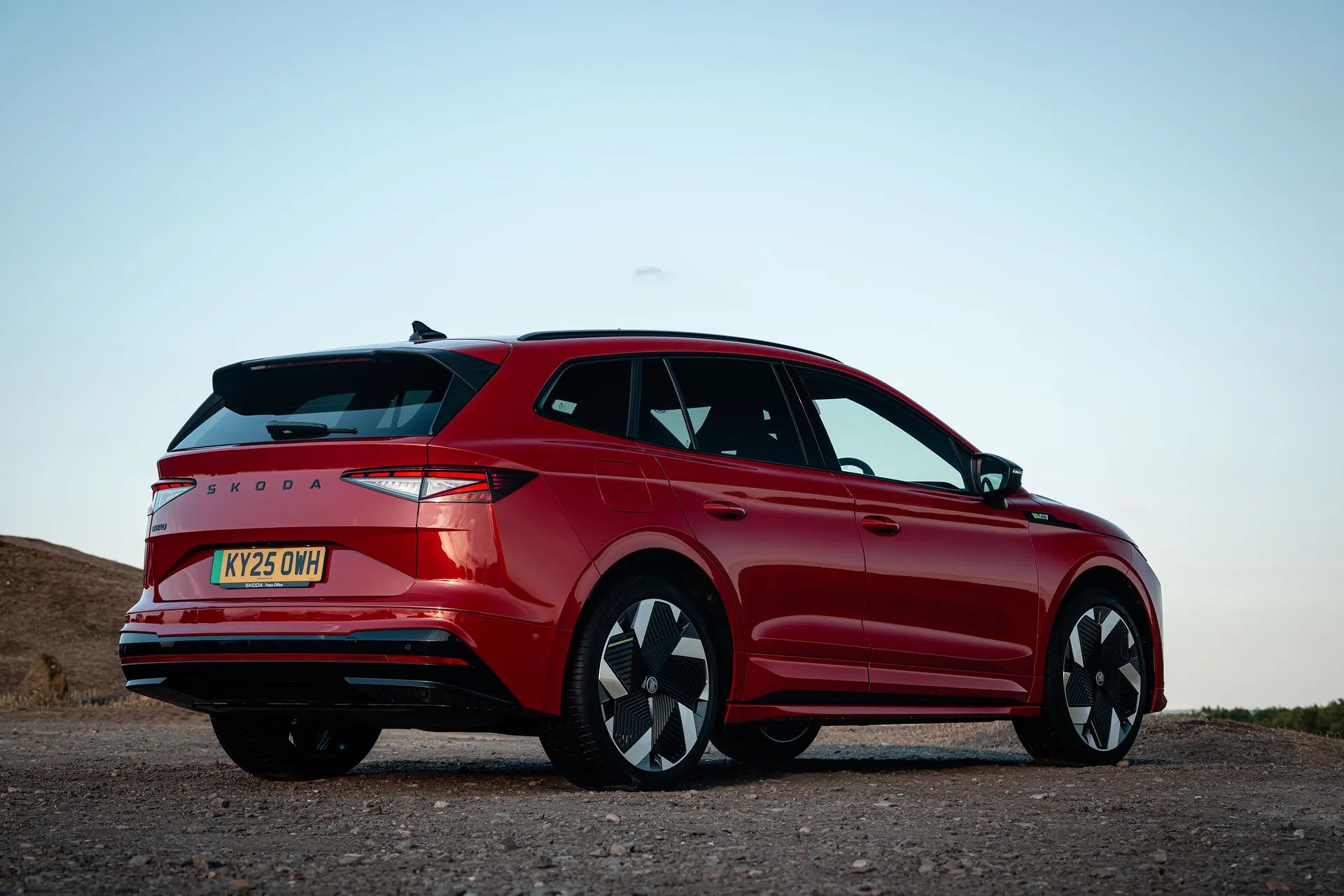
Currently, it's £51,660 for the SUV, and £53,560 for the Coupe. Each works out at nearly £3,000 more than the equivalent SportLine 85x, which doesn't seem like such a bad deal considering you're getting the Maxx package, £1,700 on that model, for free. Then again, if you're not already looking at the pointier end of the Enyaq range, it's going to look expensive, with the cheapest model starting from under £40,000.
Although we think the facelifted version looks a lot smarter, you could save a good few thousand pounds but opting for a pre-registered version of the Enyaq iV vRS, which will benefit from the 2024-on powertrain and range improvements. Or if you go older, we've seen early used versions that are still very fresh going for as little as £30,000.
None of these figures are relevant if you're a company car user. Should that be the case, you'll be able to run an Enyaq for a very low monthly figure thanks to all EVs enjoying a 3% Benefit in Kind (BiK) company car tax rate.
Trim levels and standard equipment
As the range-topping version of the Enyaq, the vRS, as you'd hope, comes with plenty of equipment as standard. The comprehensive list includes 20-inch alloy wheels, matrix LED headlights, tinted rear windows, a hands-free electronically operated tailgate, triple zone climate control, electrically adjustable and heated front seats, a heated leather steering wheel, adaptive dampers, remote parking assistance, a Canton sound system, and a 13.0-inch infotainment system.
The above can be enhanced above, for instance with a Winter Package (heated windscreen and heated front seats) for £450, or an energy-saving heat pump for £1,100. The latter feels like something which should be fitted as standard, though.
Ask the heycar experts: common questions
How much does the Skoda Enyaq iV vRS cost?
How far can the Skoda Enyaq iV vRS travel on a charge?
What does Skoda vRS mean?
Get our latest advice, news and offers
Keep me updated by email with the latest advice, news and offers from heycar.
By submitting you agree to our privacy policy